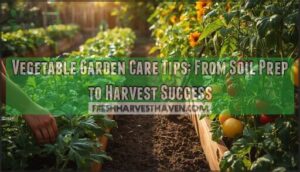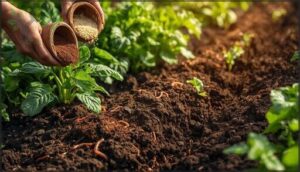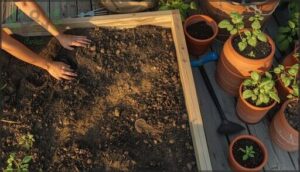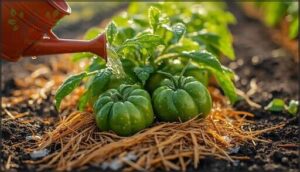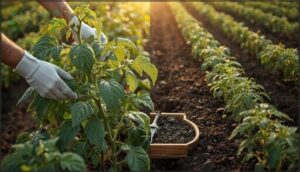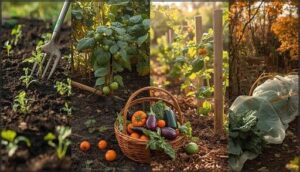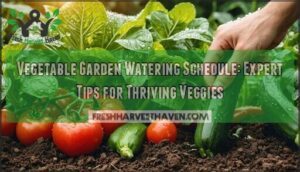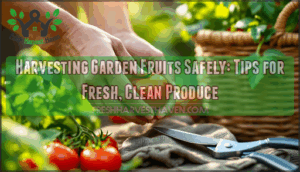This site is supported by our readers. We may earn a commission, at no cost to you, if you purchase through links.
Most vegetable gardens fail because of a handful of preventable mistakes—not lack of effort, but simple missteps in timing, watering, or soil prep. You plant with hope, tend with care, and then watch your tomatoes crack, your lettuce bolt, or your squash wilt from some mysterious blight.
The difference between a struggling patch and a thriving harvest often comes down to understanding what your plants actually need at each stage. Good vegetable garden care tips aren’t about doing more work; they’re about doing the right work at the right time.
Once you learn to read your soil, time your plantings with the seasons, and spot trouble before it spreads, growing food becomes less guesswork and more rhythm.
Table Of Contents
- Key Takeaways
- Planning Your Vegetable Garden
- Preparing and Enriching Garden Soil
- Watering and Mulching Best Practices
- Managing Weeds, Pests, and Diseases
- Seasonal Maintenance and Growth Support
- Frequently Asked Questions (FAQs)
- How do you care for a vegetable garden?
- How do you plan a vegetable garden?
- Do you need help planning a vegetable garden layout?
- How do you protect a vegetable garden?
- How do I choose a good site for my vegetable garden?
- Is vegetable gardening a good idea for beginners?
- What vegetables grow best in containers?
- How do I save seeds for replanting?
- When should I start seedlings indoors?
- Can I grow vegetables in partial shade?
- Conclusion
Key Takeaways
- Most garden failures stem from preventable mistakes in timing, watering, or soil prep rather than lack of effort, and success comes from doing the right work at the right time instead of simply working harder.
- Proper garden planning before planting—including selecting a spot with six-plus hours of sun, understanding your frost dates and hardiness zone, and starting with a manageable 100-square-foot plot—sets you up for a thriving harvest from day one.
- Deep watering techniques (reaching 30 cm down), paired with a 2-3 inch mulch layer, build resilient root systems while cutting water use by up to 50% and slashing weed control labor by 90%.
- Weekly pest inspections, crop rotation between beds, and keeping a garden journal that tracks what worked and what didn’t can boost yields by 13-20% while preventing disease cycles and pest buildups.
Planning Your Vegetable Garden
Before you dig your first hole or plant a single seed, a little planning goes a long way. Think of it as drawing a map before a road trip—you’ll save time, avoid frustration, and set yourself up for a harvest you can be proud of.
Let’s walk through the key decisions that’ll help your garden thrive from the start.
Selecting The Best Garden Location
Choosing the right location for your vegetable garden sets the stage for a thriving harvest. Before you grab your shovel, scout your yard for a spot that checks these boxes:
- Sunlight Exposure: At least six hours of direct sun daily
- Water Access: Within 15 meters of a reliable water source
- Soil Quality: Well-drained, loamy soil rich in organic matter
- Tree Proximity: At least 6 meters from mature trees to avoid root competition
- Garden Size: Enough space for pathways and crop rotation
To boost yield, consider how seasonal sun changes will affect sunlight exposure.
Assessing Sunlight and Shade Requirements
Once you’ve found your garden spot, it’s time to map the sunlight. Track how many hours each area gets by observing shadow patterns every two hours from morning to evening.
Most vegetables need six to eight hours of direct sun for strong yields, though leafy greens show better shade tolerance and can thrive with just four hours.
This mapping helps you match crops to conditions. Understanding the plant’s sunlight requirements is essential for healthy growth.
Choosing The Right Plot Size
Now that you know your sunlight map, you’re ready to size your plot. Start small—beginners do best with 100 square feet (think 10×10 feet), or even a 4×8-foot bed. This keeps weeding and watering manageable while you learn.
Consider these beginner plot size guidelines:
- One person: 40–80 square meters if aiming for garden self-sufficiency
- Average household garden: 96 square feet yields about 128 pounds per season
- Space per person: Smaller plots work fine when you focus on high-yield crops
Remember, you can always expand your garden next year once you’ve mastered the basics and understand your yield expectations.
Companion Planting and Layout Tips
Once you’ve settled on plot size, think about who gets planted next to whom. Companion planting—grouping crops that help each other—boosts yields by 20–35% and cuts pest problems. Tomatoes love basil, carrots hide from flies near onions, and diversity fights disease.
Mix botanical families in your layout, space taller plants north so they don’t shade neighbors, and you’ll harvest more with less fuss.
Understanding Local Climate and Frost Dates
Why does your neighbor’s tomato harvest dwarf yours? Often, it’s understanding frost dates and Hardiness Zones. Your climate dictates timing:
- Zone 5: Last frost April 7–30, first frost October 13–21
- Zone 7: Last frost March 22–April 3, first frost October 29–November 15
- Zones 10–13: Nearly frost-free year-round
- Zone 1: Growing season squeezed between May 22 and August 31
Match varieties to your zone’s growing season, and you’ll extend harvests by weeks while dodging crop loss.
Preparing and Enriching Garden Soil
Think of your garden soil as the foundation of a house—it needs to be strong before you start building. Good soil doesn’t just happen on its own, but with a few practical steps, you can turn average dirt into a nutrient-rich home for your vegetables.
Soil is your garden’s foundation—strengthen it with practical steps to transform dirt into a nutrient-rich home for vegetables
Let’s look at three essential ways to prepare and enrich your soil so your plants can truly thrive.
Adding Compost and Organic Matter
Think of compost as a soil superhero—it boosts organic matter, which improves water retention and helps roots breathe better.
When adding compost, aim for a C:N ratio near 25–30 for stable nutrients. Mix it 5–6 inches deep during soil preparation.
Watch out for contamination risks like plastics in store-bought batches, and test homemade compost quality using simple germination trials.
Using Organic Fertilizers Effectively
When soil testing shows gaps in nutrients, organic fertilizers step in to balance what your plants need. Application rates matter—you’ll generally need more material than synthetic options, but the payoff comes in yield stability and improved nutrient dynamics over time.
Blood meal, fish emulsion, and composted manure all work differently, so match your choice to your soil’s specific requirements while considering environmental impact.
Soil Preparation for Raised Beds and Containers
Raised beds and container gardening demand a completely different soil approach than traditional in-ground plots. You’ll want to fill your beds with a balanced blend—roughly 50% topsoil mixed with 50% compost or organic matter creates that loose, crumbly structure plants crave.
For containers on pavement, aim for at least 20–30 cm depth and boost organic matter content to buffer roots from heat and rapid drying.
Watering and Mulching Best Practices
Once your soil is ready to go, your next job is making sure your plants get the water they need without drowning them or leaving them thirsty. A good watering routine paired with the right mulch can cut your garden chores in half while keeping your veggies healthier.
Let’s walk through how to water smart and mulch right, so your garden practically takes care of itself.
Determining Water Needs for Vegetables
Your vegetable garden generally needs about an inch of water each week, but don’t let that number fool you—it’s not one-size-fits-all. Seasonal water needs shift dramatically, with summer demanding up to two inches during heatwaves.
Check soil moisture levels regularly, and watch how weather impacts your watering needs. Sandy soils drain faster than clay, so your irrigation approach should match your garden’s personality.
Watering Techniques for Optimal Root Health
How you water matters more than how much—deep watering techniques build resilient root systems that shrug off drought. Here’s how to get it right:
- Water deeply to 30 cm (about a foot) using drip irrigation or soaker hoses, cutting water use by up to 50% compared to sprinklers.
- Time it right—morning watering reduces evaporation by 30%.
- Space sessions wisely: leafy greens need frequent sips; tomatoes and carrots prefer deep drinks every 10-14 days.
- Maintain stable soil moisture to boost root crop yields by up to 94%, avoiding overwatering that splits carrots and invites root rot.
Benefits and Types of Mulch
Once you’ve mastered watering techniques, mulching benefits become your secret weapon for easier gardening.
A 2-3 inch layer delivers powerful advantages: weed suppression drops emergence by 60-90%, water conservation cuts irrigation needs by 30-50%, and temperature regulation keeps roots 5°C cooler in summer heat.
Choose from organic mulch types like straw or shredded wood for soil health, or plastic mulch for faster spring harvests.
Mulching to Conserve Moisture and Suppress Weeds
Now that you’ve picked your mulch, proper application makes all the difference. Spread a 3-4 inch layer across your vegetable garden beds—less won’t suppress weeds effectively, more risks root rot. Keep mulch an inch away from plant stems to prevent disease.
This simple technique boosts soil moisture retention by 16% and slashes weed control labor by up to 90%, transforming your garden maintenance routine.
Managing Weeds, Pests, and Diseases
Your vegetables are growing strong, but weeds, pests, and diseases can quickly turn a thriving garden into a frustrating mess. The good news is that a few simple, consistent habits can keep most problems in check without reaching for harsh chemicals.
Let’s walk through practical strategies to protect your plants and keep your garden healthy all season long.
Daily and Seasonal Weeding Strategies
When you spot weeds emerging before they hit two inches tall, you’ll cut competition for water and nutrients by half. Weekly weeding works well for most gardens, but bump it up to every five days during spring and summer’s growth spurts.
In fall, pull out crop debris and consider planting cover crops—they’ll knock down next season’s weed pressure by 40 percent while enriching your soil.
Regular Garden Inspections for Pests
You’ve cleared the weeds—now let’s catch pests before they throw a party. Weekly inspections during the growing season help you identify problems early, saving up to 50 percent on pest control costs. Walk your rows and check leaves, stems, and soil for aphids, beetles, or caterpillars.
- Look for chewed leaves or sticky residue
- Inspect undersides of foliage where pests hide
- Note any unusual spots or wilting patterns
- Use your phone to snap photos for identification
Organic Pest and Disease Control Methods
How do you fight bugs without reaching for chemicals? Start with botanical insecticides like neem oil, which knocked out 89 percent of aphids in organic trials. Introduce biological agents—ladybugs can slash aphid numbers by 74 percent in a month.
Physical barriers like row covers cut cabbage worm damage by 81 percent, while disease-resistant varieties and beneficial habitat enhancement round out your organic pest control arsenal.
Promoting Plant Health to Prevent Problems
Prevention beats treatment every time. Choose resistant varieties to dodge common diseases, maintain garden hygiene by removing debris, and boost plant diversity to confuse pests.
Strong soil health feeds healthy roots, while clean irrigation quality prevents pathogen spread. Proper spacing improves air circulation, cutting fungal issues in half.
When you nurture these fundamentals, your plants naturally resist trouble.
Seasonal Maintenance and Growth Support
Your garden doesn’t just need a strong start—it needs the right care at the right times to keep producing all season long. From knowing when to plant and harvest to rotating crops and keeping plants in top shape, seasonal maintenance keeps your garden thriving.
Let’s look at a few key practices that’ll help you support steady growth and better harvests throughout the year.
Timely Planting and Harvesting Tips
Timing your planting and harvesting can make or break your harvest. You’ll want to count backward from your local first fall frost date—usually around mid-October in many areas—using each vegetable’s days to maturity.
For instance, carrots need 70–80 days, so plant by late July for a fall crop. Early planting risks bolting in lettuce and spinach, while delayed harvest cuts yields substantially.
Crop Rotation and Succession Planting
Rotating crops between beds each season breaks pest cycles and boosts yields by roughly 13%, while succession planting—sowing quick growers like lettuce every week or two—keeps your harvest rolling in all summer long.
- Rotation benefits: Switch plant families yearly to cut disease pressure and balance soil nutrients.
- Planting intervals: Seed salad greens every 7–14 days for steady harvests.
- Sequence design: Follow heavy feeders with nitrogen-fixing beans or peas.
- Intensive planting: Tuck fast crops beneath tall tomatoes to get the most from space.
- Relay sequences: Harvest early peas, then plant beets in the same bed for fall.
Pruning and Deadheading for Healthier Plants
Snipping away suckers and spent blooms isn’t busywork—it’s one of the smartest moves for plant health and bigger harvests. Pruning timing matters: trim tomatoes in early spring to cut fungal disease by up to 40%, and deadhead basil to double your leaf haul.
You’ll also see fruits ripen faster and yields climb 15% or more, making every cut count toward a healthier, more productive vegetable garden care routine.
Keeping Garden Records for Improvement
Think of your garden journal as a major advantage for yield tracking and smart vegetable garden maintenance. Jotting down planting dates, pest history, weather patterns, and soil amendments sharpens your garden planning and crop rotation decisions year after year.
Gardeners who document what worked—and what flopped—see harvests jump up to 20%, making soil testing tweaks and harvesting timing much easier next season.
Frequently Asked Questions (FAQs)
How do you care for a vegetable garden?
Like tending a living tapestry, vegetable garden care weaves together soil amendments, consistent watering, fertilizing, pest and disease control, seasonal tasks, and harvest timing—all working together to transform your plot into a thriving, productive space.
How do you plan a vegetable garden?
Planning your vegetable garden begins with garden site selection. Assess sunlight exposure, determine your plot size, and map out companion planting arrangements.
Understanding your climate and creating garden plans ensures healthy growth and abundant harvests.
Do you need help planning a vegetable garden layout?
You’ll need a garden layout that maximizes space optimization and accessibility planning. Start by sketching crop rotation zones, then map planting areas with pathways woven through for easy maintenance and harvest success.
How do you protect a vegetable garden?
Your garden is a fortress worth defending. Protect it with tall fences for animal deterrents, mulch for weed control and soil health, pest barriers like organic sprays, and disease prevention through proper spacing and air circulation.
How do I choose a good site for my vegetable garden?
Your ideal spot receives 6–10 hours of direct sunlight daily, drains well, and sits near water access. Avoid frost pockets, wind exposure, and tree competition.
Choosing the right spot with proper soil drainage and garden layout ensures healthy growth.
Is vegetable gardening a good idea for beginners?
Absolutely—like striking gold in your backyard. Beginner gardening tips show 71% of new gardeners feel successful, you’ll save money on groceries, boost your health, and grow easy vegetables like lettuce with minimal effort.
What vegetables grow best in containers?
Tomatoes, peppers, leafy greens, and bush beans thrive in container gardens with proper soil and drainage.
Even root vegetables like carrots and radishes succeed when you choose deep enough pots for their roots.
How do I save seeds for replanting?
Picture perfectly ripe tomatoes bursting with seeds—your next harvest starts here.
Saving seeds means choosing self-pollinating varieties like beans and tomatoes, then drying them thoroughly before storing in cool, moisture-proof containers for replanting.
When should I start seedlings indoors?
Start seeds indoors six to eight weeks before your last frost date for most vegetables. Check your seed packet guidance for crop-specific timing, since peppers need ten weeks while lettuce only needs two to three weeks.
Can I grow vegetables in partial shade?
Yes, you can! While most fruiting crops worship sunlight, shade-tolerant vegetables like leafy greens and root crops thrive with just four to six hours of partial sun needs daily in your garden.
Conclusion
A neglected garden becomes a battleground of weeds and pests. A well-tended one turns into a rhythm you can follow without thinking twice.
These vegetable garden care tips aren’t about flawlessness—they’re about paying attention, adjusting as you go, and trusting the process. Your soil will improve, your instincts will sharpen, and your harvest will grow more abundant each season.
The garden teaches patience, and patience always pays off in bushels.
- https://ucanr.edu/program/uc-anr-small-farms-network/guide-fertilizing-vegetables
- https://content.ces.ncsu.edu/extension-gardener-handbook/16-vegetable-gardening
- https://www.usda.gov/about-usda/general-information/initiatives-and-highlighted-programs/peoples-garden/soil-health/cover-crops-and-crop-rotation
- https://njaes.rutgers.edu/pubs/commercial-veg-rec/irrigation-management.pdf
- https://edis.ifas.ufl.edu/publication/HS388

